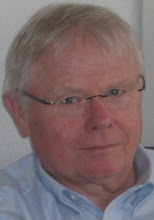 According to the explanations given in the exhibition from which I have reported yesterday, there is a lot of politics in Vermeer's Gezicht op Delft. The Nieuwe Kerk in the right part of the screen (here a part of the painting) was deliberately brought into the light, while the left half of the screen is still overshadowed by a cloud of rain.
According to the explanations given in the exhibition from which I have reported yesterday, there is a lot of politics in Vermeer's Gezicht op Delft. The Nieuwe Kerk in the right part of the screen (here a part of the painting) was deliberately brought into the light, while the left half of the screen is still overshadowed by a cloud of rain.
The Nieuwe Kerk was painted, so the exhibition says in that special light because of its importance to the royal family. The church is, in fact still today one of the largest churches in Holland and the burial place of the Dutch royal family. Most recently, Prince Claus von Amsberg was buried here, in 2004.
We read this kind of political theory and remember the lesson unfolded a thousand of times: the equality of politics and art. It is repeated over and over again by educative radio programs and television broadcasts. Since Napoleon told Goethe that Politik ist unser Schicksal (politics is our fate) art is subordinated to politics.
We hope there will one day be a new Willy Brandt (Die Schule der Nation ist die Schule, the school of the nation is the school) telling us that fate is our fate. Life means to love, to be loved, to eat, drink, sleep, and - did not Mozart say so? – to shit a warm shit. All this forms the basis for a personal fate, a destiny, never influenced by politicians.
From Vermeer’s standpoint as an artist, the placement of the church into pure sunlight and the  decision to leave the roofs on the left side in the draining rainwater, has many plausible reasons. The church with its yellow walls sparkles most beautifully in the bright sun, whereas the roofs shine wonderfully salmon, since the rain has wetted them and the light falls a little subdued on them.
decision to leave the roofs on the left side in the draining rainwater, has many plausible reasons. The church with its yellow walls sparkles most beautifully in the bright sun, whereas the roofs shine wonderfully salmon, since the rain has wetted them and the light falls a little subdued on them.
What can be known about Vermeer's plans for the picture is that he has painted the church much lower than it realy was. A bolt broke the top of the tower, later in 1872, it was replaced thereafter by an even higher tower, which today measures 109 m. Vermeer wanted to paint the city skyline as an almost uniform band and has therefore pressed down the existing towers and has bended the gate on the right side towards the side of the screen.
Nothing of this has to do with politics. Marcel Proust lets his poet Bergotte die at the sight of the painting, in a Paris exhibition. Bergotte’s last look goes to a small piece of wall, right next to the gate, in the bright half of the screen, at the edge of the painting.
Marcel Proust lets his poet Bergotte die at the sight of the painting, in a Paris exhibition. Bergotte’s last look goes to a small piece of wall, right next to the gate, in the bright half of the screen, at the edge of the painting.
His dizziness increased; he fixed his gaze, like a child upon a yellow butterfly that it wants to catch, on the precious patch of wall. "That's how I ought to have written," he said. "My last books are too dry, I ought to have gone over them with a few layers of colour, made my language precious in itself, like this little patch of yellow wall.
Rendre ma phrase en elle-même precieuse, comme ce petit pan de mur jaune.
And then Bergotte dies, mumbling repeatedly petit pan de mur jaune avec un auvent, petit pan de mur jaune.
Little patch of yellow wall, with a sloping roof.


No comments:
Post a Comment